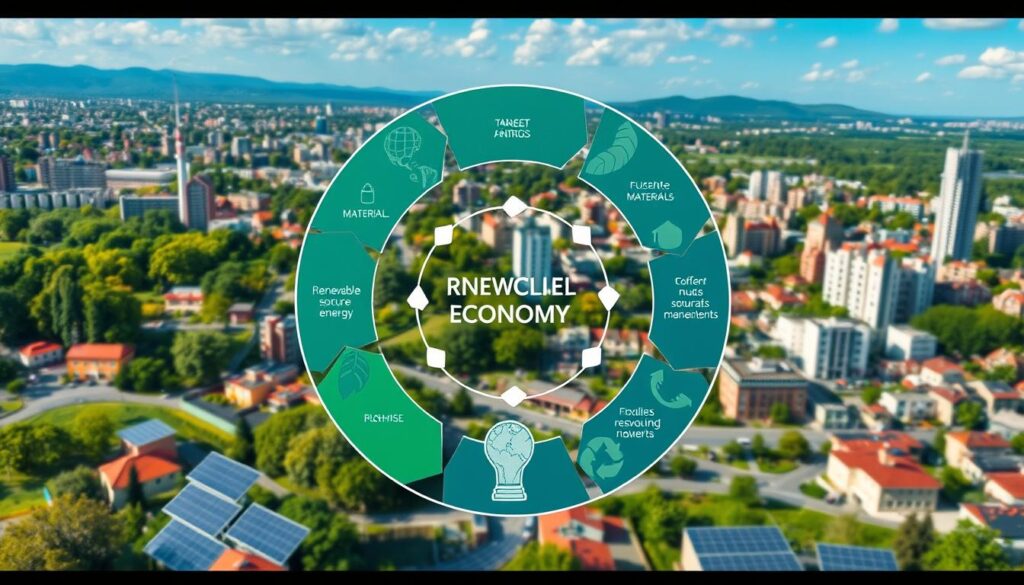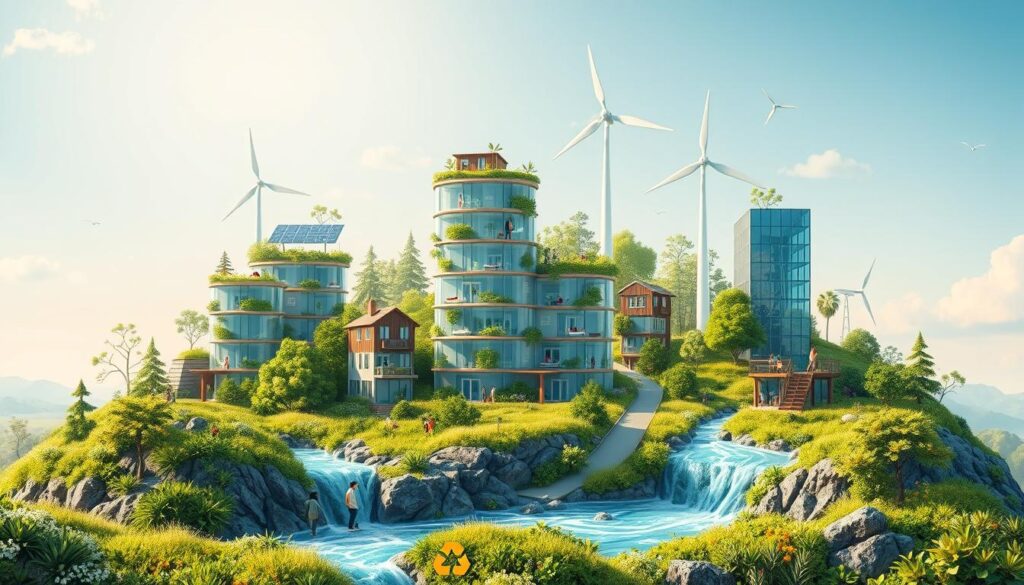Sustainable Business Strategies for Lasting Success

Thinking about my own business journey, I see how vital a good business strategy is. It must focus on growth and making money over time. A key part of this is creating a sustainable business model.
This model should be built to last, with a focus on planning and steady income.

With a solid business strategy, companies can make a real difference and succeed for years. This means building a strong base, finding growth chances, and encouraging new ideas and flexibility. In this article, we’ll dive into what makes a sustainable business model great and how to build one for lasting success.
Key Takeaways
- Developing a sustainable business model is crucial for long-term success
- A successful business model prioritizes strategic business planning and sustainable revenue streams
- Creating a strong business foundation is essential for lasting growth and profitability
- Innovation and adaptability are key to staying competitive in today’s market
- Implementing a well-thought-out business strategy can help businesses achieve long-term success
Understanding the Foundation of Business Sustainability
To succeed in business, having a long-term plan is key. This plan should focus on sustainable practices that benefit both the company and the environment. Understanding the basics of business sustainability is crucial for profit.
Exploring sustainable business, I’ve learned it’s more than just profit. It’s about positively impacting the planet and people. A good plan should include practices that care for the environment, support communities, and ensure financial health.
- Embracing eco-friendly practices to reduce carbon footprint
- Implementing socially responsible initiatives to support local communities
- Developing a triple bottom line approach that prioritizes people, planet, and profit
By using these sustainable practices, businesses can thrive and help society. A solid long-term plan is vital. It should focus on caring for the environment, supporting communities, and making money.
My Journey to Building a Sustainable Business
Looking back, I see how vital sustainable revenue streams and strategic business planning are. These two have been key in making my business profitable and lasting.
I’ve learned that sustainable revenue streams are crucial for success. It means having different ways to make money, investing in new ideas, and keeping an eye on market changes. This way, my business isn’t just dependent on one thing and can handle market ups and downs better.
Strategic business planning has also been important. It’s about setting goals, spotting risks, and planning how to deal with them. This approach helps me stay ahead and make smart choices that grow my business.
Some strategies I’ve used include:
- Regular market research to keep up with trends
- Investing in my team’s growth to keep them skilled and motivated
- Using eco-friendly practices to lessen my business’s environmental footprint
By focusing on sustainable revenue streams and strategic business planning, I’ve built a business that’s both profitable and sustainable. I hope my story can inspire others to create their own sustainable business models.
| Strategy | Benefits |
|---|---|
| Sustainable Revenue Streams | Reduced reliance on a single revenue stream, increased resilience to market fluctuations |
| Strategic Business Planning | Improved decision-making, increased competitiveness, and driven business growth |
Essential Elements of Long-Term Business Success
To achieve long-term business success, focus on building a strong foundation. This means several key elements that help grow and profit. By understanding and using these elements, businesses can succeed and make a lasting impact.
Creating Value for Stakeholders
Creating value for stakeholders is key to long-term success. This is done by developing products or services that customers need. Also, by building strong relationships with suppliers and partners, and investing in the community. This builds a positive reputation and trust with stakeholders.
Building Strong Customer Relationships
Building strong customer relationships is vital for a strong foundation. This is done by providing excellent customer service and offering personalized experiences. Also, by encouraging feedback and loyalty. This creates a loyal customer base and drives growth.
Developing Efficient Operations
Efficient operations are crucial for long-term success. This is achieved by streamlining processes and reducing waste. Also, by investing in technology. This reduces costs, improves productivity, and gives a competitive edge.
How to Create a Sustainable Business Model for Long-Term Success
To make your business last, you need a solid plan. Start by knowing your market and what makes you special. Then, make a plan to reach your goals. A good plan helps you make smart choices and use resources well.
When you’re planning, think about these important points:
- Define your mission and vision statements
- Conduct market research and analyze your competition
- Identify your target audience and create buyer personas
- Develop a unique value proposition and competitive advantage
By taking these steps, you can build a business that lasts. A sustainable business does more than make money. It also values its customers, workers, and the planet.
Starting this journey takes time and effort. You must be ready to change as the market does. Stay true to your goals and keep improving your plan. This way, your business will thrive for years to come.
| Business Strategy Element | Description |
|---|---|
| Market Research | Conducting research to understand your target market and competition |
| Unique Value Proposition | Developing a unique value proposition to differentiate your business from competitors |
| Target Audience | Identifying and creating buyer personas for your target audience |
Developing Your Strategic Vision
Reflecting on my journey, I see that a strategic vision is key for growth. A clear vision guides my decisions and actions. It helps me stay focused on my goals.
For a successful business, you need a long-term plan. This plan should be both reachable and adaptable. By setting measurable goals, I can see how I’m doing and adjust as needed.
- Do market research to grasp trends and what customers want
- Find out what you’re good at and what you can improve
- Create a unique value that makes your business stand out
By following these steps and sticking to my growth plan, I aim for a lasting business model. A clear vision is vital for success and a lasting business model.
Building Revenue Resilience
To make your business last, you need sustainable revenue streams and strategic business planning. This means having different ways to make money and a plan for surprises. It helps your business stay strong even when the market changes.
Some important ways to make your business more resilient include:
- Diversifying your revenue streams to reduce dependence on a single source of income
- Developing a strategic business planning process to anticipate and respond to changes in the market
- Creating a culture of innovation and adaptability to stay ahead of the competition
By using these strategies, your business can handle tough times better. It’s more likely to succeed in the long run.

Also, sustainable revenue streams come from understanding what customers need. Make products or services that meet those needs. This builds strong customer relationships and a loyal base, key for growing revenue over time.
To build revenue resilience, mix strategic business planning, innovation, and focusing on customers. Follow these steps to build a business that can thrive for years to come.
| Strategy | Description |
|---|---|
| Diversification | Reducing dependence on a single source of income |
| Strategic Planning | Anticipating and responding to changes in the market |
| Innovation | Staying ahead of the competition through innovation and adaptability |
Implementing Sustainable Operations Practices
As I work on making my business profitable, I’ve learned how crucial sustainable practices are. These practices help reduce environmental harm and boost efficiency. This way, businesses can thrive while protecting the planet.
Some key strategies for sustainable operations include:
- Resource optimization strategies: This means cutting down on waste and using resources like energy and water more wisely.
- Environmental impact management: This involves steps to lessen the harm our business activities cause, like cutting carbon emissions and starting recycling programs.
- Supply chain sustainability: This means choosing suppliers who care about the environment and working to make our supply chain greener.
By using these strategies, businesses can lessen their environmental harm, work better, and build a sustainable model. This helps the planet and makes the business more profitable. As a business owner, it’s key to focus on green practices and keep finding ways to get better and adapt to new environmental challenges.
By embracing sustainable practices, businesses can ensure they last long and help make the future greener. This needs a dedication to always getting better and being ready to change with the environment. As a business owner, I’m all in on green practices and creating a model that’s good for my company and the planet.
| Strategy | Benefits |
|---|---|
| Resource optimization | Reduced waste, improved efficiency |
| Environmental impact management | Reduced carbon emissions, improved environmental sustainability |
| Supply chain sustainability | Improved supply chain efficiency, reduced environmental impact |
Creating a Culture of Innovation and Adaptability
To achieve long-term business success, creating a culture that encourages innovation and adaptability is key. This means making sure employees feel free to share their ideas and take risks. This way, businesses can keep up with changes and build a solid base for growth.
Some ways to build such a culture include:
- Encouraging experimentation and learning from failures
- Providing chances for professional growth and training
- Supporting open communication and teamwork
By using these methods, businesses can foster a culture that drives long-term business success. This culture is vital for facing challenges and achieving long-term business success as the market changes.
By focusing on innovation and adaptability, businesses can stay ahead of rivals and achieve long-term business success. This requires a dedication to learning and improving, along with a readiness to take risks and try new things.
| Strategy | Benefits |
|---|---|
| Encouraging experimentation | Drives innovation and learning |
| Providing opportunities for professional development | Enhances employee skills and knowledge |
| Fostering open communication and collaboration | Improves teamwork and problem-solving |
Financial Planning for Long-Term Sustainability
Exploring sustainable business, I see financial planning is key. It’s vital for a business model to last. To achieve long-term success, a solid financial plan is needed. This includes budget allocation strategies, risk management approaches, and investment in growth opportunities.
A good business strategy is essential for lasting success. It means setting clear financial goals, watching expenses, and making smart investments. This proactive approach helps avoid risks and seize chances, leading to long-term success.

Key Financial Planning Strategies
- Develop a comprehensive budget that allocates resources effectively
- Implement risk management approaches to minimize financial risks
- Invest in growth opportunities that align with the business strategy
By using these strategies and focusing on how to create a sustainable business model for long-term success, businesses can reach long-term sustainability. A well-planned business strategy is the key to success.
Measuring and Monitoring Business Sustainability
To achieve long-term business success, it’s key to measure and monitor business sustainability. This means tracking important performance indicators and making adjustments when needed. It helps ensure the business is on the right path to its goals and creating a strong business foundation.
Some key areas to focus on when measuring and monitoring business sustainability include:
- Financial performance: tracking revenue, expenses, and profits
- Environmental impact: monitoring energy consumption, waste management, and carbon footprint
- Social responsibility: assessing employee satisfaction, community engagement, and customer relationships
By regularly reviewing these areas, businesses can spot where they need to improve. This helps make informed decisions for long-term business success. As a business owner, I know that creating a strong business foundation is vital for lasting success.
Here is a simple table to illustrate the importance of measuring and monitoring business sustainability:
| Area of Focus | Key Performance Indicators |
|---|---|
| Financial Performance | Revenue, Expenses, Profits |
| Environmental Impact | Energy Consumption, Waste Management, Carbon Footprint |
| Social Responsibility | Employee Satisfaction, Community Engagement, Customer Relationships |
Scaling Your Sustainable Business Model
Building a profitable business means scaling my sustainable model. I focus on a growth strategy that’s good for the planet. This way, my business can grow and help society at the same time.
To scale, I’ve pinpointed a few key areas:
- Growth strategy development: I set clear goals and make a plan to reach them.
- Market expansion techniques: I find new markets and customers, and figure out how to reach them.
- Partnership opportunities: I work with other businesses to achieve our goals together.
I’ll keep focusing on sustainable practices. This ensures my business is profitable, responsible, and ethical. I aim to leave a positive legacy for the future.
| Strategy | Benefits |
|---|---|
| Growth strategy development | Increased revenue, improved competitiveness |
| Market expansion techniques | Access to new customers, increased market share |
| Partnership opportunities | Shared resources, expertise, and risk |
Overcoming Common Sustainability Challenges
To create a sustainable business model for long-term success, it’s key to tackle common sustainability hurdles. One major challenge is crafting a business strategy that considers economic, social, and environmental factors. This approach helps businesses manage risks and seize opportunities.
Challenges like resource depletion, climate change, and social inequality are common. To beat these, businesses can start by adopting green practices. This includes cutting down energy use, starting recycling programs, and fostering diversity and inclusion. Such actions help reduce environmental impact, boost reputation, and enhance competitiveness.
Moreover, collaboration and knowledge sharing are crucial for developing strong sustainability plans. By teaming up with various stakeholders, businesses can learn from each other, share best practices, and spark innovation. This keeps them competitive and successful over time. By mastering how to build a sustainable business model and having a solid strategy, companies can excel in today’s fast-paced world.
Conclusion: Your Path to Sustainable Business Success
Creating a sustainable business model is key to lasting long-term business success. By following the strategies in this article, you can build a strong foundation. This will help your company thrive for years.
Developing a strategic vision and implementing sustainable operations are crucial. Each step helps make your business resilient and adaptable.
On your journey to sustainable success, stay true to your core values. Keep innovating and always learn more. Embracing business sustainability secures your company’s future and helps the environment.
Believe in your vision and trust the process. Let your sustainable business model lead the way to a prosperous future.
FAQ
What is a sustainable business model?
A sustainable business model aims for long-term success. It focuses on the triple bottom line: people, planet, and profit. This approach benefits the company, the environment, and the community.
Why is it important to create a sustainable business model?
Creating a sustainable business model is key for lasting success. It builds a strong foundation and develops sustainable revenue streams. It also ensures profitability and growth over time through strategic planning.
What are the key components of a sustainable business model?
A sustainable business model has several key components. These include a strong foundation, sustainable revenue streams, and strategic planning. It also involves optimizing resources, managing environmental impact, and fostering innovation and adaptability.
How can I measure and monitor the sustainability of my business?
To measure your business’s sustainability, track key performance indicators. Monitor progress and make adjustments as needed. This ensures your business is on track for long-term success.
What are some common sustainability challenges and how can I overcome them?
Common sustainability challenges include financial constraints and regulatory changes. You can overcome these by diversifying revenue streams and staying informed on regulations. Building a resilient supply chain and fostering innovation also help.
How can I scale my sustainable business model for long-term growth?
To scale your sustainable business, develop a growth strategy. Identify market expansion techniques and explore partnerships. This increases profitability while maintaining sustainability.
What is the importance of financial planning in creating a sustainable business model?
Financial planning is crucial for a sustainable business model. It involves budget allocation, risk management, and investing in growth. A solid financial plan ensures long-term viability and profitability.
How can I create a culture of innovation and adaptability within my business?
To foster innovation and adaptability, create an environment that encourages creativity and risk-taking. Implement employee training, reward innovative ideas, and welcome feedback and new perspectives.




